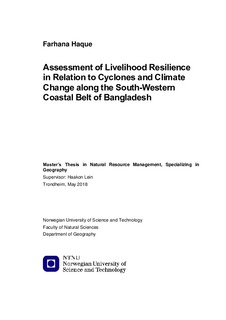| dc.description.abstract | The world has started to witness the increased frequency and severity of extreme natural disasters, due to the impact of climate change. This added risk for already vulnerable coastal poor as their lives and livelihoods largely depend on natural resources. Regarding this, the southwestern coastal part of Bangladesh is most vulnerable as it is hit by cyclone almost every year due to its geographical position. Most recently, two consecutive cyclones, Sidr in 2007 and Aila in 2009, struck Bangladesh and left the southwestern coastal people to bear enormous sufferings. Following the disaster, several helping agencies started to work to improve their livelihood condition in the affected areas. This study was conducted in Dacope upazila of Khulna district which was one of the worst impacted by cyclone Aila. The specific objectives are to investigate livelihood patterns, to identify their most impacted sectors as well as to explore their survival strategies against adversity. Overall 160 households were interviewed using semi-structured questionnaire to collect data from four villages of Dacope upazila. Additionally, two Focus Group Discussions were conducted. The collected data were analyzed using descriptive statistics, frequency distribution, chi-square, and logistic regression. The findings indicate that the households are relatively poor as they have low income, poor housing and facing food and water challenges. The major losses due to cyclone were observed in house damages and income loss. Challenges related to transport, and food and water storing due to adversity were also detected. Results revealed that households primarily relied on own resources both before and during cyclone for surviving and managing themselves. Whereas, during the post cyclone period they relied on helping agencies for their coping and recovery. The study discovered lack of community-based intervention and less medical facilities in the areas. Temporary migration of households was found both before and during cyclone to avoid the unfortunate consequences. The households require more assistances both from Government and non-government organizations to recover satisfactorily. Since information on vulnerable aspects, livelihood pattern, coping, and recovery of households at local level are hardly found in Bangladesh, these findings could be useful in designing different intervention programs for capacity building to manage cyclones. | nb_NO |
